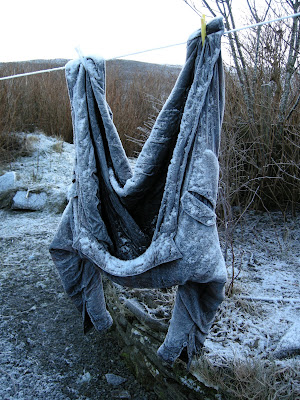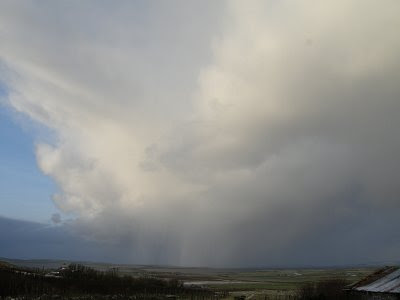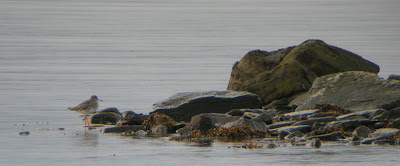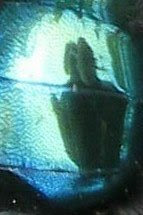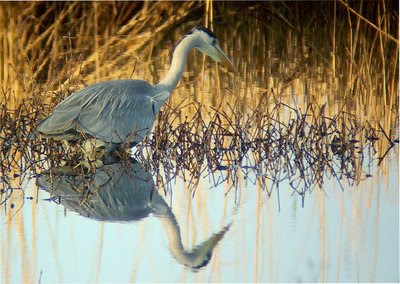
Nov 29, 2008
Nov 28, 2008
Bloody chilly
Its been a quiet week for birding all round so far this week. With a bit of luck we will go out with a bang on Tim’s class ,Sunday. Another single Waxwing yesterday. Overnight wet snow froze to create an icy glaze over everything. The Kestrel returned to hunt along the burn and over the house today, A quick snap was taken..Red Grouse were calling behind the house today. This was enough encouragement to take the dog up the hill. Work is all digging at the moment so I decided to have the day off as it was so cold….its a grand life…Still little was to be seen out and about in the heather. The heather its self was covered in a skin of ice adorned with a deep frosting looking for all the world like shining white corral in the sun. All to soon the threatening weather made us retreat after only managing Wren and Blackbird for the list. Never mind it was nice to get the blood pumping a bit before sundown.
Nov 25, 2008
Snowed in and no birds
The last few days have seen us snowed in with fans across the tracks. All in all its been a disappointing few days for birds with only the few local birds that are about coming to the ground feed I put out. All to soon it was discovered by Hoodies or the hens and quickly consumed. Raptors have been well represented though with Sparrow hawk, Kestrel and Merlin. The Merlin is an infrequent visitor around the valley and great to see. This one made a long and fast low pass across the tops of the bushes following the burn down hill. Stonechats from the burn were in the garden a couple of times and that’s about it for this place and the weekend. Over in the next valley today I had no sooner got to work when two Goldcrests twittered through the bushes in front of me. Then later A single Waxwing flew close overhead making a load of racket. Two good birds in an hour…aint that the way of it!!
Nov 21, 2008
Nov 20, 2008
Nov 17, 2008
Sea bird report summary 08
The following is a summary of the sea bird report summary from the RSPB. If you are members of the society and part of the local members group then you will have all ready have been privy to this information. One of the advantages of being a member of the RSPB is the huge amount of up to date information you can draw on. Orkney is in the enviable position of having one of the highest memberships per head of population in the
Red Throated Diver
The season started poorly and the birds seemed in poor condition on their return to the county. Eventually they got going though. On Hoy for example 56 occupied sites produced 43 chicks from 32 nests. The same as 06 and better than 07. On the mainland things were poorer, 19 monitored pairs raised just eight chicks. At the main site seven pairs reared no chicks at all and there was evidence that the high level of Greylag goose activity had a detrimental effect.
Manx Shearwater.
15 calling birds were estimated in and around the only known colony.
Fulmar
Overall productivity seemed a bit higher at sites monitored this year
Gannet
The only sea bird that seems to be holding its own On Westray’s Noup Head colony the Apparently occupied nests(AON)from 106 in 2006 to 345 this summer an increase of 107%!!
Shag
Little solid data exists for shags in Orkney but one off visits to Swona and the Muckle Skerry suggested that productivity was down and the breeding season was late.
Arctic Skua
A very dismal year. 108 nests were monitored by Iain Maclean for RSPB and had a productivity of just 0.06. No young at all were reared in the study plots on Westray,Rousay,Mainland or Flotta with slightly more success on Stronsay,Eday and Papy. This probably reflects the lack of a food source(fish kleptoparasitised from Arctic Terns). This was also reflected in sightings of them hunting and eating song birds and Orkney voles. On Pappy they were seen eating Crowberry berries. All droppings around nest sites were found to contain the remains of beetles…desperate times.
Great Skua.
A strange situation it appeared to seasoned observers of the biggest colony on Hoy that numbers were in real decline yet at other sites there has been an increase over the last twelve years of 67% It is a possibility that the threat of cannibalism in high density areas due to the ongoing food shortages has driven the birds to redistribute to lower density areas
North Hill on Papa Westray did not to bad with 20 apparently occupied territories AOT’s reared 18 chicks. A healthy figure and comparable to that in 07.
Black Headed Gull
A poor season for them with the main colony at Mill dam Shap holding only 90 AON and failing completely. Most other colony’s also failed and dispersed. The most successful site was Boardhouse Loch where a colony was still thriving on 10th July.
Common Gull
Breeding success was varied but poor. Sandy Loch, Hoy had 78AON’s with 67 chicks raised and two colony on Eday produced only 3 chicks. Exceptionally dry conditions did not help as the ground was to dry for to long to be finding important earth worms. Colony’s were also prey to heavy predation from larger gulls and Bonxies leading to failures.
Herring Gull
Another gull species that had a variable season. At Burray Ness 100 adults were present and 39 nests were recorded from which 41 chicks were ringed. On Grass Holm20 pairs raised at least 15 chicks. It was a gloomier picture from other sites with few if any chicks raised.
Great Black Backed Gull
The largest decreases in this species were seen on Hoy. The once enormous colony at the Burn of Forse that once held one thousand birds contained only fifty adults. Further north at Stourdale a colony that once held 600 pairs only had15 AONs. Copansay held 335 AONs this year compared to 380 in 2000 a decline of 12%
Kittiwake
A whole colony count on Copinsay 4th June produced a total of 1881 AONs compared to 4364 in 2000 a decline of 57%
Detailed monitoring of five mainland sites resulted in 353 nests being observed and not a single chick was raised. Here and there a few chicks were raised and out on Muckle Skerry(28th June) things appeared to be going well with 127 nests with 46 with chicks. 55 had brooding or incubating adults, unfortunately the difficulty in accessing this colony made follow up visits impossible.
Arctic Tern
Once again this spices suffered a disastrous breeding season. By may birds were returning and settling down to breed but failure after failure occurred and colony’s right across the isles were abandoned by June The only reasonably successful site was on the rock stacks at Skiba Geo,Birsay. Here 80 adults were in attendance and reared 20 chicks.
Common Tern
The main colony on the old wooden pier at Lyness,Hoy held140 adults on may 22nd and 90 birds were attending nests but was soon abandoned soon after this date.
The only known colony at Well Park Papy held 46 adults on the 9th June but failed shortly after with no chicks reared.
Little Tern
13 Adults were at the regular site but only one chick is thought to have been raised. A pair that nested and laid on North Ron also failed.
Guillemot
This species continues to go down hill rapidly.
A whole colony count on June 4th gave a total of14593 adults compared to 19549 in 1999 a 25% decline.
Anecdotal evidence sugested that the large colony’s on Noup Head and Marwick Head were much depleted this year. Dennis Paice monitored 125 nest sites at Marwick and Mull Head and not a single one of these raised a chick. It was a similar story on Papa Westray’s Fowl Craig. No young were raised from the 221 adults counted on the cliffs.
Razorbill
This auk is also experiencing real problems.
A whole colony count of the Copinsay group on June 4th gave a total of only 201 adults. This compares to a total of 671 in 2000 a 70% decline and322 in 2005 a 38% decline.
On Fowl Craig Pappy a max of 31 adults were counted with only two chicks. It is not known if they fledged. On Swona 5th July 8 chicks were ringed compared to 72 in 1999.
Black Guillemot.
Counts were down slightly across the isles.
An important colony appears to be developing on Grass Holm. 100 adults were there on the 8th June when many nests were found while on 28th July 15 nests were found with mainly with broods of two.
Puffin
Few relevant data were collected in 2008 although 348 adults were counted on the Copinsay group on June 4th. The major colony on Sule Skerry was not visited this year.
Overall it looks like another year of decline in sea bird numbers with quite a few species suffering minimal breeding success. Auks and terns faired very poorly with Fulmars seeming to be holding their own along with Gannets. Bonxies looked poor on the ground but did surprisingly well away from the dense colony’s Red Throated Divers picked up after a slow start while the breeding success of the gull species was very variable although fairly poor.
Not a pretty picture.
The following pepole and orginisations are to be warmly thanked for their invaluable contributions to this report(that I have just skimed over in this summary)
Bob Adam, Bill Badger, Chris Bell, Chris Booth, Mike Cockram, Collin Corse, Lorna Dow, Kieth Fairclough, Mark Gurney, Paul Higson, Paul Hollinrake, Andy Knight, Allan Leitch, Iain Maclean, North Ron bird observatory, Barry O’Dowd, Dennis Paice, Ian Smith, Brian Ribbands, Lea Shields, Jim Williams, Stuart Williams, Tim Wootton….Not to mention Eric Meek for contributing and compiling it all.
Thanks to you one and all.
Nov 16, 2008
Quiet sunday
It was a no birding day today. I missed five Chaffinches in the garden which was a bit gutting as it would have been an Orkney record for me! Five in the one place exciting stuff. I would swap my next three Merlin’s for them no probs!! The only other birds I had were geese. From the stonyhill road looking down to the Harray Loch something put up the geese all along the shore. Geese rose in skein after skein along with balls of golden plover and starlings. There were a huge number of geese in the air. To much to count but I would guess five thousand plus. It was a fantastic sight and the noise carried well over the relatively still fields. A superb ten minutes!
Nov 15, 2008
Nov 13, 2008
Over the past few days things have been ticking over. The paddock seems alive with Pheasants at the moment. Redwings and a few Fieldfares have been in the scrubby fields in front of
Nov 11, 2008
Nov 9, 2008
Nov 8, 2008
Nov 7, 2008
A quiet day.
It was quiet but still a good day for birds. We were spiking apples and a woodcock flew over probably put up by Ruby’s dog. I stopped for a coffee about two thirty and a good flock of thrushes flooded by the window heading up the valley. They seemed longer than the Redwings that have been about and in greater number than I have seen so far so I would hazard a guess they were Fieldfares. Last bird of the day came as I was taking pictures of the setting sun illuminating a cloud burst. I was filming the scene panning around when a Peregrine obligingly flew down the valley for me. It turned out only a dot on the film so I don’t suppose I will post it. Its been all right with the weather as well finaly got stuff on the line. winds back to SE.
Its been a funny sort of day to day, one of those with highs and lows. It was misty and wet at day break. The mist rolled down to about half way to the heathers edge. Conditions were like this from yesterday afternoon. Walking the circuit with the dog little is to be seen below the house but around the corner is a sheep with its head completely stuck in a bit of doubled fence wire so the first act of the day is a sheep rescue. I had to straddle it to hold it still whilst I got its head and ears (both full of tags) out of the trap with out it getting hurt. I’m glad there was no one about to see…double glad there was no one with a camera. Mind you I did take a photo as I approached it. I think I am becoming a compulsive snapper. Any way out the field over the brig and up the track we were away. Stonechats and Wrens were quite vocal. There were a few more Blackbirds than usual I think. The Redpolls appeared moving about near the burn then took to the air and up the hill to the big patch of gorse. At the Hoodies nest a Wren showed really well in the tree. A Robin sang and another replied some where up the valley. Robins have been coming about the house for a while now but they are flighty skulking things that appear for a moment and move to back to cover. Below the ruin there is movement that draws the eye. Goldcrests are flitting about feeding in the sycamore and surrounding bushes. At one point I see one being set upon by a Wren. I had never seen this before, the Wren chased it off big style. The fascinating thing was the comparison in size with the Wren dwarfing the Goldcrest. It really brought home to me how small these wee birds are. All to soon the dog has spooked them so I move up to the quarry. There are Redwings rising out of the heather on the approach with more coming from the fuchsia that grows from the walls. Black birds stick about in cover and Stonechats appear but little else, the mist closes and drizzle starts so we head back to cross the we bridge and head over the back field to home. I nearly step on a pheasant which always makes the heart beat. Apart from four Twite passing over head nothing is seen the whole length of the field.
The day ended well with the RSPB local group AGM and talk. The annual report reaffirmed some depressing trends that continue and the talk on climate change did little to cheer me up. It was however very interesting to hear from a meteorologist and birder. It was also well presented and informative leaving you with a lot new information to think about.
Nov 5, 2008
Nov 4, 2008
Out and about out west.
With another stunningly calm and sunny morning I decided to take a spin out west. I really needed to be concentrating on my photo year list but high tides were not really in my favour, So the plan was a casual scan across the lochs and on to Rango for a few waders.
Stopping first at the Stenness stones for a look I whiled away a few minutes with Eric Meek who was passing. But all the while I was talking I was aware of the gentle splash of fish in the water before me. So as Eric shot off I concentrated my efforts looking across the bottom of the Stenness loch. The tide was fully up with on space for waders around the sides. Shoals of fish continually disturbed the surface. I am guessing they were small trout. Strangely they didn’t seem to attract any attention from the myriad of gulls that were loafing about. Out on the water Big flocks of Widgeon moved slowly around. Tufted duck and Mallard were well represented. The soporific calls of Long tailed duck drifted over the still waters. Scoping them out in the middle of the loch you could see the males posturing before the females beginning to sort things out for the next breeding season. Looking towards the brig half a dozen Goldeneye of both sexes milled about feeding in the moving water floe between the two lochs. Scoping the stubble fields beside the Brodgar bird crop a flock of Snow buntings could be seen twisting and turning before settling back down to feed in the wet stubble.
Moving on to have a look over the Brodgar pools it was Widgeon that dominated the scene with a few Mallard. I was hoping for something a bit different but it wasn’t to be. A bit of excitement flared up as contractors fired up there grass cutting machienery. This put fifty plus Curlew in to the air along with a load of Lapwings. These all circled and landed around the pools bringing a bit more interest. A few Redshanks and the occasional flight of a Snipe completed the picture. Saddling up and moving on I aim for the end of Stenness Loch below Voy. Below the farm of Lyking a massive flock of Curlew stretch across the fields and down to the loch edge. A truly impressive sight.
Stopping at a passing place on the hill looking down on the loch below Voy there is a good gathering of wildfowl. All the usual suspects are there but try as I might I just cant find a single Scaup for the list. It’s an enjoyable task sorting through the throng though. The Crannogs hold a few Redshank but little else of the wading variety. I roll down the hill with the idea of checking out the bays beyond Voy but give it up as the sunlight is low and shining strait in the face so I keep on going. From here I head to Rango to look for waders. A nice Bar tailed godwit would be an addition. On arrival its evident that my luck is out. The rains of late have filled the loch to brimming and there is no mud to be seen anywhere. There are a few ducks on the loch and some Snipe roosting on an island but little else of interest. In the fields on the opposite side it is another story. Here we have a big flock of Golden plover. They are spread almost the whole length of the loch. Spread through them and around the periphery are good number of Lapwing. Below all of this 2 to 300 Curlew are at roost. I watch for a while and as I do the flock takes of time and time again, spinning around and landing back in the same place more or less. (there is a bit of film in the local films) It was not what I really wanted but it was a fantastic spectacle none the less…..Birding. I love it!!
Book Review
It has been a long wait for The Orkney Book of Birds but at last it is finally here. Written by Tim Dean and illustrated by Tracy Hall. The book is lavishly illustrated with beautiful colour plates painted by the renowned wild life artist Tracy Hall. Her illustrations capture the essence of the birds portrayed exquisitely to give a real feel to the birds. This is so much better than a photograph can achieve. All of the subjects are painted at the locations they can be commonly found and it’s a fascinating challenge to pick out the locations from the illustrations. The real genius of it is that although the locations are well represented the back drop at no time draws your attention away from the bird in the foreground. There are 187 birds contained on 50 colour plates. A huge undertaking and so well executed that every single one is a cracker.
The author Tim Dean is a life long birder with a huge love of the subject. In the introduction Tim gives a fascinating review of the birding year in Orkney. He also explains the reasons he got in to birding and his motivation for writing the book. One thing he explains is the reason for just having 187 birds in the book. Basically these are the birds you are likely to find across Orkney through out the year. The list could be expanded to 400 or more if you were to count all the species that have had single occurrences over the years or the birds that appear once in a blue moon. Concentrating on the birds you will find and where you are likely to find them year round makes real sense for some one who wants to hunt down the birds of Orkney. Keeping to the well known names that are in common parlance rather than using the BTO descriptions will hopefully make birds a bit more recognisable to most lay folk that read the book. Where there is an Orkney name or a Scots name for a species then this is included along with a grading of how easy to difficult it is to find the particular bird. The text also will tell you about a birds relevance to the British and European scene if appropriate. Mostly it will concentrate on the history of the particular bird in the county and when where and how you might see it for your self. Each description is concise, packed with information and very well written.
Tim Dean and Tracy Hall have produced a book here that is an absolute gem. Well written and illustrated. It is packed with information and unlike other field guides that tell you what to look for this book will tell you all that and where about in the county to go look to find your bird. Descriptions like land mark and definitive are not going to be out of place describing this book. It’s a cracker…get one!!
Published by The Orcadian ltd (
01856 879001 (the Orcadian office).
It is launched this week. Tim and Tracy will be signing copies at the Orcadian book shop on Saturday morning.
Marks out of ten…..eleven!!
Nov 2, 2008
Sunday class with Tim Dean.
At 10.30 this morning five of us turned up at the Holm community centre car park for this months Tim Dean all day birding class. The weather as forecast was stunning with some high cloud and blue skies. To add to the effect the wind dropped all day letting the surface of the sea fall nice and calm. You really couldn’t ask for better, it was a bit of a contrast with last months. The first bird of the day was a Waxwing that was coming to apple and a berry bush. Fantastic birds and a first for some of the class. We watched it come and go for a wee while. Out attention was also take by a Dunnock singing from the top of a fir tree. Fun as it was we heade3d off down the back lane bit to have a look over the Loch of Ayre. The whole loch is hooching with birds as usual. The Whooper swans massively out number the Mutes today. The males are argumentative with each other producing continuing bouts of blokish behaviour..all very entertaining. The majority of the ducks are Widgeon with tufted and mallard the next most represented. Saying that I would have thought there would have been more tufted duck about. We exercised our scopes and bins for a bit picking out Male and female Gadwall and male and female Goldeneye. A car stops and it turned out to be Keith Hague who tells us there is a goosander around the corner and out of our sight. Its an excellent tip as it’s a bird I need for the old photo year list. We all wave him on his way and pile across the road to the shore track and sure enough Tim is the first one to get on it. He calls it sitting on the bank. A quick snap and its mine. We check out all the Mergansers we can see looking for another…and there are a few but with no luck so we are off back to the cars. After an uneventful walk back we are putting scopes away and chatting when suddenly every thing rises. There are flocks of Starlings followed by a flock of Golden Plover. Every thing is in a panic. Whilst we are looking for the cause a Sparrow hawk shoots across the car park feet from us at ankle height with a Starling in its talons. It pulls up in to an impossibly steep climb and pops over the community centre to disappear into the gardens beyond. Stunning, leaving behind it settling panic and a memory of whooshing feathers…..its wagons roll for Hunda.
Crossing the barriers the hunt is on for our target bird the Grey Phalarope. Yesterday there were none to be seen along the barriers so today the plan is to go to the
Hunda is a small island that at one time supported nine pepole. Nowadays it is left to the sheep. It is conect6ed to the
Even though it is getting dark and we are about done the birding go’s on. A spy over the water reveals a large flock of Mergansers starting their roost. A count up has 75 with another 25 or more on the other side of the barrier. These lift off to settle with the big flock giving over a hundred..how smart is that!! Wondering how you top that the sound of gun fire towards the hope has put up Geese and by the sound of them lots of geese. Sure enough here they come filling the skies Fifteen hundred maybe more…who knows. The air it thick. They fall out the sky in a twinkling of an eye. With in a minute or so they are in a huge flock in the middle of water sound with the sun setting behind them…..Not a bad end to a not bad day.
Nov 1, 2008
Its a two bird day.
A good day today. I managed to get a photo of a Redpoll in the garden which is another addition to my county photo year list not to mention the garden list!! This morning a flock of twittering birds came over the house and settled. Listening to them and not recognising what they were I ran round to the front to find three Redpolls in the sycamore starting to feed. There were more in the willows across the paddock. I grabbed my bins and after a minute the scope. I managed a few shaky shots as I struggled to split my time between watching through the scope and taking photos. Classic way to get crap photos which I did of course. At sunset I walked the dog up the valley and they were still about so it looks likely they will roost there and might be about at first light!
The other birds of the day were nine Waxwings. I was working on the north end of the back road when I heard there calls. I ran up the road to see them pass over head. I think they were the same ones as reported by almootie today as it was almost the same time as his report. I think there were three reports today on orkbird and a couple more on Orkney forum. It looks like the mainland has a fair smattering of them. I will be going back to Stromness to see if I can add to the year list the morn…..yeehaa..
